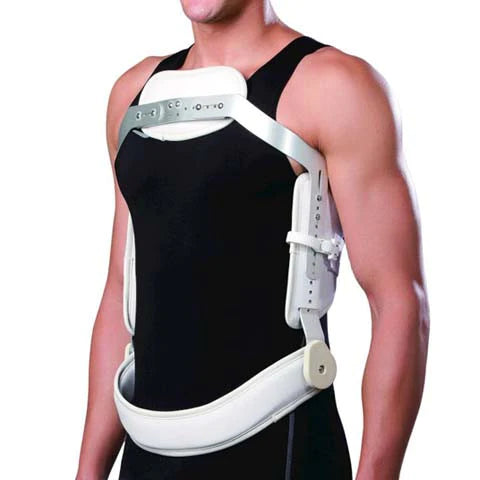
Optimizing Recovery with the Jewett hyperextension Brace: A Guide for Spinal Rehabilitation
What is a Jewett Brace?
The Jewett brace is a medical orthotic device primarily used for stabilizing and supporting the thoracic and upper lumbar regions of the spine. This brace is particularly effective in treating compression fractures of the thoracolumbar spine, which can occur due to conditions like mild osteoporosis or minor trauma. The design of the Jewett brace aims to limit forward flexion (bending forward) of the spine while allowing a certain degree of extension (bending backward) and lateral bending, thus facilitating the patient's mobility and recovery process.
Typically constructed from metal and plastic, the Jewett brace consists of a framework that encircles the chest and abdomen, along with a vertical support that fits along the back. The design of the Jewett brace focuses on providing the necessary stability while minimizing restrictions on the patient's daily activities. Physicians, considering the specific conditions and treatment needs of the patient, recommend the use of the Jewett brace and make appropriate adjustments to ensure its fit and comfort.

Understanding the Spinal Column
The spinal column, a complex structure, consists of bones, joints, ligaments, tendons, the spinal cord, and nerves. It has several critical functions:
- Providing structural support and balance for an upright posture.
- Protecting the spinal cord, nerve roots, and certain internal organs.
- Allowing flexible movement.
Injuries to the spine, such as fractures, dislocations, subluxations, and damages to joints, ligaments, and tendons, can destabilize this system. These injuries, often taking up to three months to heal, may require surgical intervention for proper treatment.
Diagnosing Spinal Injuries
Spinal injuries are typically diagnosed using X-rays, MRI, and CT scans. For effective healing and to prevent further injury, it is imperative that the spine remains correctly positioned and the injury is stabilized.
Fitting and Adjusting the Jewett Brace
A trained orthotist or experienced nurse will initially fit your Jewett brace. As you begin to move and your condition evolves, adjustments to the brace might be necessary. It is crucial that only qualified professionals, such as your orthotist or a qualified nurse, make these adjustments to ensure the brace is functioning optimally and not causing additional harm or discomfort.
hyperextension brace
The hyperextension brace is a type of spinal orthosis used to stabilize and support the spine, particularly in the thoracic, lumbar, and sacral regions. This brace is designed to prevent forward bending (flexion) of the spine, promoting healing and alignment in cases of spinal fractures, surgeries, or other spinal conditions.
Key Features of the Hyperextension Brace:
Design: It typically consists of a front chest pad, a lower abdominal pad, and a rear pad that rests against the lower back. These pads are connected by metal bars that keep the spine in an extended (straightened) position.
Function: By restricting forward motion of the spine, the brace helps in the stabilization of spinal fractures and post-surgical healing. It is especially useful in treating compression fractures of the thoracic and lumbar spine.
Application: The brace is applied while the patient is in an upright position. Adjustments are made to ensure a snug but comfortable fit, allowing minimal flexion of the spine.
Comprehensive Guide for Applying and Managing Your Jewett Brace

How to Apply Your Jewett Brace
-
Initial Position: Begin by lying on your back in bed.

-
Step 1: Place the brace across your chest and abdomen. Keep the lock on the left side open at this stage.

-
Step 2: Using the log roll method (as taught in the hospital), roll onto your side. Ensure the spine support pad is correctly positioned over the area of your injury.

-
Step 3: Roll back onto your back. Secure the keyhole clip over the metal screw on the brace.

-
Step 4: Close and lock the left side of the brace. Ensure it's tight but be cautious to avoid pinching your skin. The brace should fit firmly.
When to Wear Your Brace
- In the shower
- While sitting, walking, and in the car
- Typically worn for 6 to 12 weeks, as advised by your spinal doctor. An X-ray may be required before discontinuing use.
When to Remove Your Brace
- Remove when lying down flat, unless advised otherwise by your doctor.
- You can remove the brace at night while sleeping.
Care of Your Brace
- Have someone else wash your brace.
- Clean with soap and water to remove sweat and dirt. If soiled, wash with warm soapy water and hang to dry.
- Reapply the brace once it is dry.
Activities to Avoid While Wearing Your Brace
- Avoid flexion, twisting, or turning of the body.
- No driving, physical sports, running, heavy lifting, or manual work.
- Consult your spinal doctor before resuming these activities.
Safety and Comfort Tips
- Wear a cotton singlet or t-shirt (seamless if possible) under the brace.
- Choose loose, comfortable clothing and practical shoes.
- Regularly check your skin for redness or blisters.
- Report any skin issues or concerns to your orthotist, nurse, or doctor.
- Shower with the brace at night, allowing time for it to dry overnight. Use plastic wrap to keep it dry during the shower.
Remember
- The Jewett brace supports your thoracic/lumbar spine by preventing twisting and flexion.
- Healing from injuries can take up to 3 months.
- Surgery may be necessary for some injuries.
This guide ensures you correctly apply, wear, and care for your Jewett brace, facilitating optimal recovery and comfort during your healing process.
In summary, the Jewett brace (HYPEREXTENSION BRACE) plays a pivotal role in the recovery from spinal injuries, especially in the thoracic and lumbar regions. Its correct application, adjustment, and use are essential for effective rehabilitation and prevention of further spinal complications. Patient cooperation and adherence to professional guidance are key to maximizing the therapeutic benefits of this crucial orthotic device.
